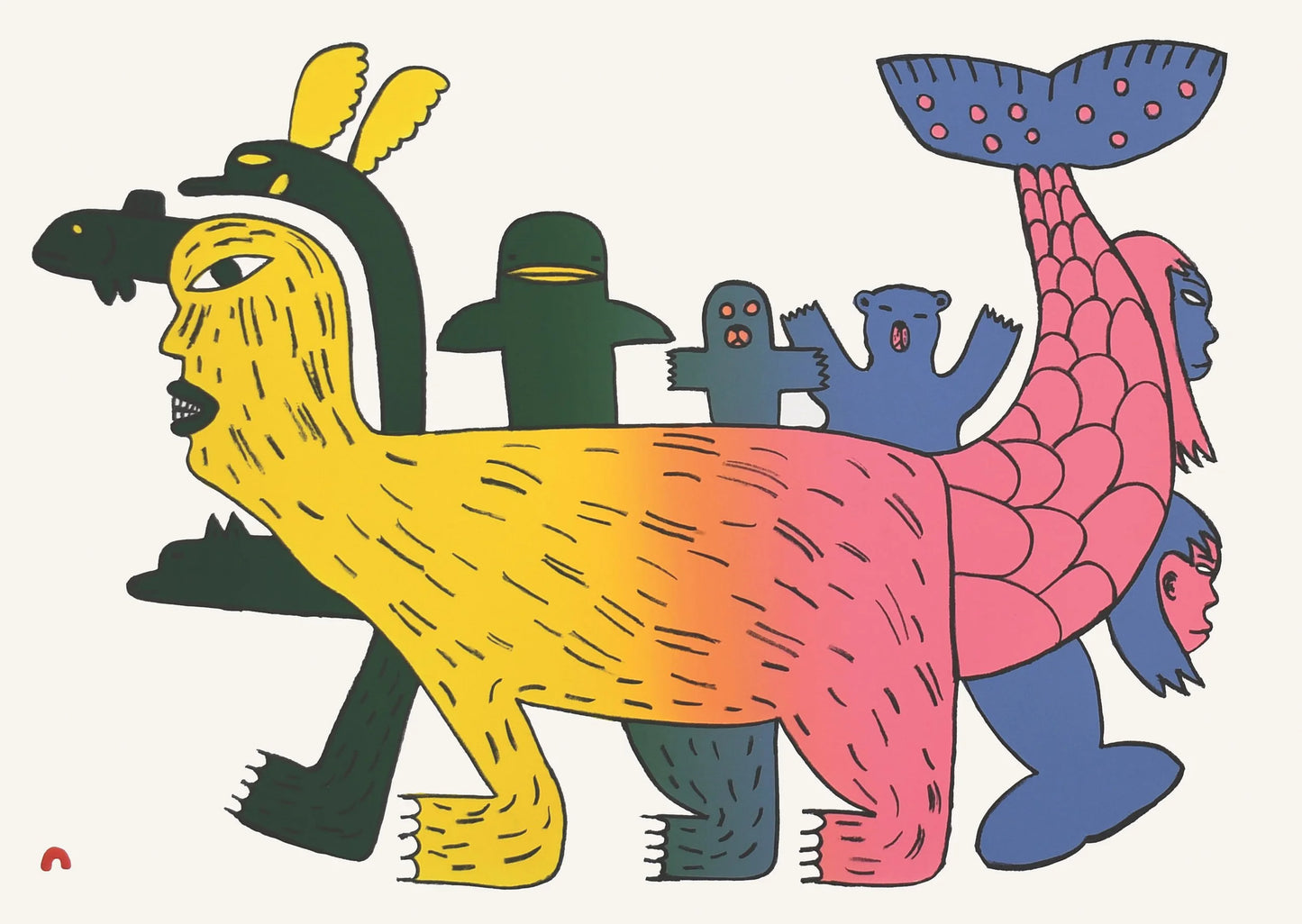Sedna's Parade
Sedna's Parade
Couldn't load pickup availability
Description
Pitsiulaq Qimirpik
SEDNA’S PARADE, 2023
Lithograph
38.3 x 55.2 cm
Dorset ID# 23-18
Pitsiulaq (Pitseolak) Qimirpik is a young Cape Dorset carver who’s quickly established himself as both apprentice (his father is renowned Dorset carver Kelly Qimirpik) and contemporary artist. Indeed, Qimirpik has successfully distinguished himself through this very juxtaposition, marrying pop-culture signifiers with traditional carving. He sits at the helm of a surging generation of Inuit artists who are reconfiguring their position onto history, traditional media, and narrative figuration. It’s a group who’s establishing itself through an aesthetic more easily situated in the contemporary artworld, while never fully divorced from its ancestral associations and formal base. Qimirpik, like so many of his contemporaries, continues to make the link between the two.
From the age of thirteen, Qimirpik has established himself through an exceptional craftsmanship and an attention to contemporary signifiers. Producing figures like muskoxen, drum dancers, and dancing walruses, his works are often colored by their subjects’ props or profiles. They don iPods or MP3 Players (as in Young Man with MP3, 2010), the white of their devices’ matte cording cutting a stark contrast to veined marble. (The ironic value lies in this plastic veneer being made of bone). Rabbits dance to hip-hop. Walruses kick up their flippers with glee. Qimirpik is falling in step with his generation’s multivalence, its double-speak, and winking referentiality. He seeks form in Inuit history, but roots his subjects in the new.
Lithography was introduced at the Kinngait Studios in the early 1970s. Unlike stonecut and etching, hand lithography requires no cutting of the printing surface. Instead, the design is simply drawn on a limestone block or aluminum plate with grease pencils or with a greasy liquid. The stone or plate is then inked with a grease-based ink while being continuously sponged with a thin film of water. The water repels the greasy ink, confining it to the area defined by the original drawing. Multi-colour prints usually require a separate stone or plate for each colour. In printing, the inked stone or plate, paper and tympan (protective covering) is cranked by hand through a press. Under tremendous pressure, the drawn image transfers to the paper. In recent years, several lithographs have included the application of chine collé. This technique involves pressing a thin sheet of sized, oriental paper to a heavier backing sheet and printing both at the same time, adding another dimension of colour and texture to the final image.
The West Baffin Eskimo Co-operative in Cape Dorset has earned a worldwide reputation for the quality and originality of limited edition prints made by its member artists. Every year since 1959 the print making studios (now known as Kinngait Studios) have released an annual catalogued collection of between 30 and 60 images as well as numerous commissions and special releases. Kinngait Studios is the longest continuous running print studio in Canada.
Although the graphic abilities of many Inuit were recognized early on from incised ornaments and tools as well as appliqued garments and bags, very little works on paper were done prior to the inception of the print making program in the late 1950’s.
Much of the success of the formative years of printmaking in Cape Dorset can be attributed to James Houston, an artist from Toronto who left the cosmopolitan south with his wife Alma and their two young sons in 1952 and lived the better part of the next 10 years in Cape Dorset. Apparently James Houston was a heavy smoker and one day Oshweetok Ipeelie, a skilled hunter and carver of walrus tusks, picked up an empty cigarette package and remarked upon the supreme patience and skill of the man who drew with painstaking precision the identical image of a sailor on each and every pack. Houston tried to explain how multiple images are made and then began to demonstrate the fundamental principles of printmaking by rubbing soot over an incised walrus tusk. He then pressed a few sheets of toilet paper over the image and pulled a few simple prints whereupon Ipeelie amazed and delighted exclaimed, “We can do that.” Thus began a quest to find a genuine, indigenous and appropriate means of printmaking.
Although several small editions of sealskin stencils were produced it was a cumbersome and limiting process. However it was discovered that the local carving stone used for sculpture was an ideal medium for relief printing and eventually the stone cut technique became the most common media of printmaking in Cape Dorset. Later on the technique of engraving was introduced and in the 1970’s the first litho press was set up. In recent times, stone cuts, etchings and lithographs have comprised the mediums of each collection thus allowing the artists a greater variety of expression.
Shipping & Returns
Free shipping in Canada for orders over $75. International shipping available. Return/exchanges are accepted within 30 days of purchase. Some conditions apply.
View full details


